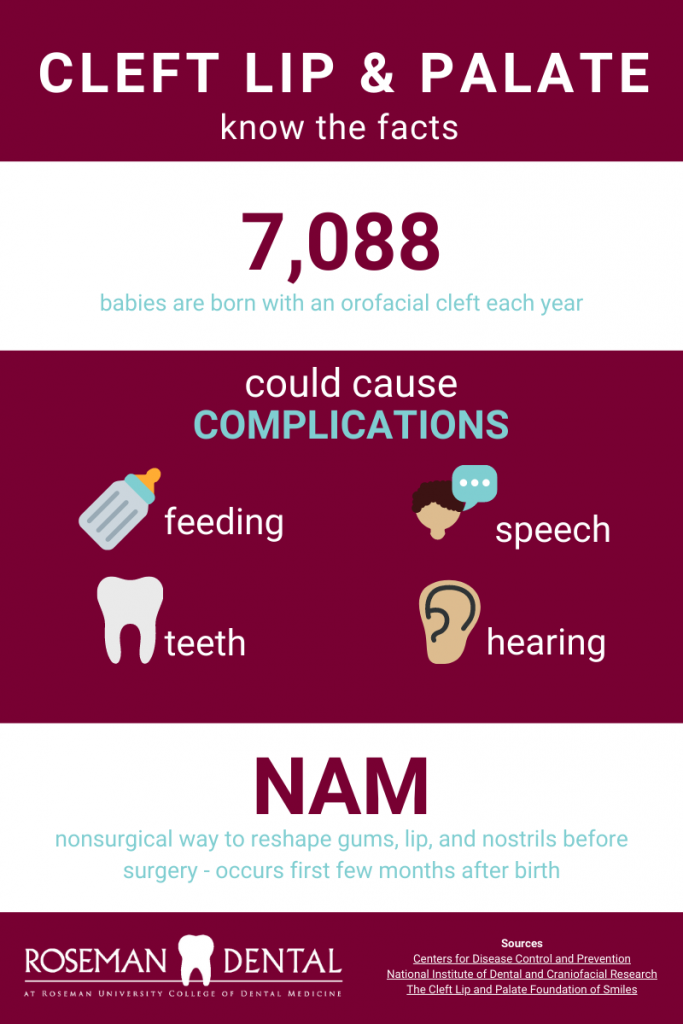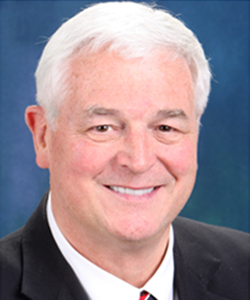Since 2008, Roseman Dental & Orthodontics has been collaborating with Nevada Early Intervention Services and the Southern Nevada Cleft Palate & Craniofacial Team that helps children born with cleft lip and palate. This team is the only cleft lip/palate craniofacial team in Southern Nevada.
Roseman Dental & Orthodontics’ orthodontic residents and faculty volunteer at the monthly clinic held at the Nevada Early Intervention Services office. The Clinic provides children up to the age of 18 and their families with a comprehensive approach and management of care which includes diagnosis, recommended treatment, psychosocial support and more all at no cost. Those served include children with cleft lip and/or cleft palate and other cranio conditions, craniofacial abnormalities, and congenital anomalies.
Additionally, Roseman Dental & Orthodontics has initiated a new approach to cleft treatment – the Nasoalveolar molding or NAM – in conjunction with a plastic surgeon that minimizes the effects of surgery and maximizes the innate growth potential of the children, leading to fewer surgeries over their lifetime.
Roseman Dental & Orthodontics has been performing NAMs at its Nevada location since 2012. Roseman Dental & Orthodontics’ NAM team consists of all the medical specialists necessary for a child’s care and development including pediatric dentists, plastic surgeons, pediatricians, ENT, audiologists, nutritionists, and speech pathologists.
What is Nasoalveolar Molding (NAM)?
NAM is a nonsurgical way to reshape the gums, lip, and nostrils with a plastic plate before cleft lip and palate surgery. Pre-surgery molding may decrease the number of surgeries a child needs because it makes the cleft less severe. A NAM is used mainly for children with large or wide clefts and has greatly changed cleft repair.
- It reduces the cleft inside the mouth.
- It reduces the gap in the upper lip.
- It lifts and narrows the nose.
Surgery takes place after the molding is complete when the child is around age four to six months.
Previously, a child with a large cleft needed many surgeries between birth and age 18, putting the child at risk for psychological and social challenges. The first surgery pulled the lip together, the second improved the position of the lip, two more would shape the nose, then another — often including a bone graft — would close the palate, and so on.
With a NAM, orthodontists at Roseman Dental can reduce a large cleft in the months before surgery. A NAM also improves the shape and position of the lip and nose. With a smaller cleft, there is less tension when the surgeon closes the cleft. Molding the lip and nose in advance can mean less reshaping is needed during surgery. With a better result from the first surgery, a child may need fewer surgeries later in childhood.
How does a NAM work?
NAM works by gently directing the growth of a baby’s gums and the shape of their nose during the first few months after birth, when these tissues are soft and easy to mold.
Parents work with orthodontists at Roseman Dental during NAM therapy. Just days after the baby is born, the orthodontist fits the baby with a custom molding plate that looks like a retainer issued after braces. The baby wears the molding plate 24 hours a day, seven days a week, including when they are feeding. The plate is held in place using denture adhesive. Medical tape is then placed from cheek to cheek over the cleft to help mold the bones inside the mouth as well as the lips. Parents, taught by the orthodontists, change the tape and clean the molding plate at home as needed (usually three to four times each day).
Every one to two weeks, the orthodontist makes small changes to the shape of the molding plate to guide the baby’s gums as they grow. Each visit takes about 40 to 60 minutes.
As the tape is closing the bones, a metal prong with a soft material covering inserts into the nose to form the molding plate. This post (called a nasal stent) slides easily into the baby’s nostril. It slowly lifts up the nose and shapes the nostril on the side of the cleft. This stent is removed approximately one week before the lip and nose repair surgery.
How does a NAM feel for the baby?
The molding plate and nasal stent are not painful. After getting used to the plate for a few days, many babies seem happier wearing it than they did without it. This may happen because the plate acts as a palate (roof of the mouth). It keeps your baby’s tongue from pushing into the cleft, making feeding easier for the baby. Without a NAM, infants have a very difficult time feeding.
See recent Las Vegas Review-Journal article about one of Roseman Dental & Orthodontics’ patients by clicking HERE.
If you are expecting a baby with cleft palate or lip, or know someone that needs help, please contact our Nevada location, Roseman Dental & Orthodontics, at 702-968-5222.




